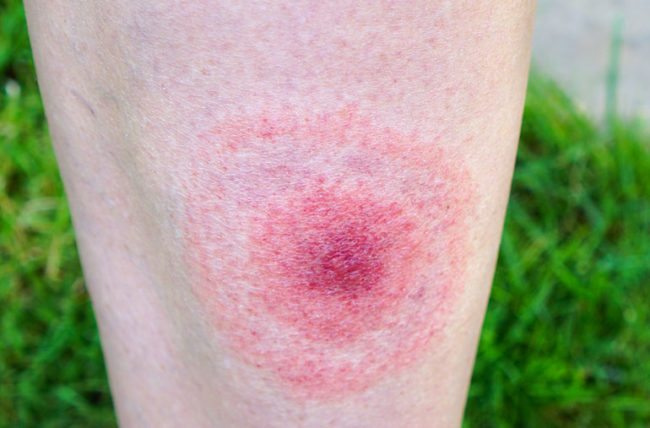I would like to sincerely thank all of you for the incredible number of responses I received to Wednesday’s blog asking for your questions and topic requests! After all, this blog is for you—so I’m happy to know what you want to hear about or are concerned about.
One comment that jumped right out at me immediately, especially this time of year, was a reader (Katherine) asking about Lyme disease.
Even though Lyme disease has been around for close to 50 years and its prevalence continues to grow, many people still don’t fully understand it, or they think that it only comes from ticks, or that all you need is an antibiotic to get rid of it.
Here’s the real story on Lyme disease and how you can help prevent it.
The beginning of Lyme disease
Lyme disease originated around 1975 and was named after the town of Lyme, Connecticut, where it was first identified.
Within two years, the deer tick was linked to the infection.
Then in 1982, scientist Willy Burgdorfer, Ph.D. discovered the bacterium responsible for the infection and named it after himself--Borrelia burgdorferi. Interestingly, it is a cousin of the bacterium that causes syphilis.
The Lyme bacterium is extremely resourceful and has a knack for hiding and survival. It can live inside your cells and encase itself in a “cyst.” That’s why treatment can be so difficult, and it can recur after antibiotics.
It starts with a tick bite—or maybe not!
The typical Lyme infection starts when a tick that is carrying the bacterium jumps off a deer, bird, rodent or other animal and latches onto you.
It immediately starts numbing your skin so you cannot feel it. It prefers dark, secluded areas such as your armpits, behind your ears or your scalp.
But ticks aren’t the only guilty parties. Lyme can also be spread by mosquitoes, spiders, fleas, and mites.
After being bitten, one of the first signs of Lyme is short-lived butterfly-shaped rash on your skin. After that, about 70 percent of people will go on to develop a bulls-eye rash on the skin.
Note that you might not get a rash at all! The CDC estimates that at least 30 percent of Lyme sufferers don’t develop any type of rash.
Other symptoms of Lyme infection include:
- Flu-like symptoms
- Poor sleep, chronic fatigue
- Nausea or loss of appetite
- Joint pains
It’s not that rare and it’s often missed
According to the CDC, 300,000 new cases of Lyme disease are diagnosed in the US each year—that’s 1 1/2 times the number of people who are diagnosed with breast cancer each year…so it’s not as rare as you might think.
Fourteen states are responsible for 96 percent of the Lyme cases reported and are primarily located in the Northeast and Upper Midwest.
As far as testing goes, current estimates show that the standard ELISA test misses at least 35 percent of Lyme cases.
That’s because the Lyme bacterium can infect your white blood cells, and when this happens, they don't respond by producing antibodies like they should. Since the blood tests measure antibody production, you can get a false negative.
So, people can suffer for a long time without being properly diagnosed!
Another test that is showing promise is direct microscopy, which is done by a limited number of laboratories at this point. It’s typically performed by holistic practitioners more than mainstream doctors, but you can certainly request if you are concerned.
It can become chronic
Lyme is typically treated with antibiotics, but some people don’t fully recover after the initial treatment and their condition becomes chronic. This is especially true of people who have weak immune function and impaired cellular function. Then you may be facing even stronger antibiotics as well as pain medications, steroids and/or anti-inflammatories.
When Lyme becomes chronic, people can suffer ongoing symptoms for months or years, and incur a significant impact on their quality of life.
Problems associated with chronic Lyme infection include debilitating fatigue, joint pains, arthritis, digestive problems, depression, and even cognitive changes like headaches, difficulty concentrating, forgetfulness, and brain fog.
Prevention first!
As is the case for most illnesses, prevention is the key with Lyme disease.
If you spend time outdoors, check for ticks daily on yourself, children and pets.
Use a non-toxic, natural insect repellant like our very own Organic Bug Repellant Essential Oil Blend.
Bathe or shower within two hours after coming in from the outdoors if possible.
If you’ve been in a tick-infested area, do a full body check and examine your clothing for ticks. Tossing your clothes in the dryer on high heat for an hour will kill any you may have missed.
And see a doctor immediately if you develop a butterfly or bull’s-eye rash.
Other ways to fight back at Lyme disease
1- Engage the power of the right diet
Nourishing your body with a healthy diet is number one.
Having a nutritious diet of whole foods helps create a healthier gut environment. Since your gut is where most of your immune system resides, by promoting gut health, you are also supporting strong immune function!
Plus, antioxidant vitamins and minerals can help fight the damage caused by infections and viruses, and the phytochemicals found in fruits and vegetables have been shown to have immune-enhancing properties.
My Great Taste No Pain health system can guide you on having a healthy, nutrient-rich diet that is positively delicious (thanks to my outstanding recipes!), as well as show you how to construct meals that are easier for your system to digest.
So, you can help prevent Lyme disease AND eliminate gas, bloating and heartburn too!
2- Supplement with probiotics and vitamin D
Having a strong immune system is critical to fighting and preventing infections of all kinds—especially Lyme disease—and when it comes to immune support, probiotics and vitamin D are the Superstars.
Super Shield multi-strain probiotic formula can help keep your population of friendly gut bacteria strong and help support your immune system’s fight against “invaders” like viruses and bacterial infections. Plus Super Shield’s full-spectrum blend of 13 probiotic strains can help your gut microbiome bounce back from the harmful hit it takes from antibiotics.
Vitamin D is crucial to help control your immune system’s inflammatory responses—and the aches, pains and fever associated with Lyme are all inflammatory reactions. Since vitamin D is a common deficiency (primarily due to limited food sources and our avoidance of the sun), supplementing with a top-notch formula like Optimum DK Formula with FruiteX-B can ensure your body has what it needs.
Optimum DK Formula gives you a whopping 5,000 IU’s of vitamin D3, plus vitamins K1 and K2 and the mineral boron, to provide top-notch immune support.
3- Additional helpful foods
Here are other foods that can fight Lyme disease and other infections:
- Foods such as garlic, leeks, onions, radishes and cabbage have anti-infectious properties.
- Helpful spices include thyme, fennel, clove, cayenne pepper and ginger.
- Mushrooms including cordyceps, reishi and maitake have been shown to activate immune response.
To your health,
Sherry Brescia












My 28-year-old grandson has been diagnosed with Lyme’s disease. He is SO sick. He is working with a chiropractic neurologist who is telling him he must kill the infection first and then build up his immune system. He doesn’t know where he contacted it – either in California where he was attending seminary in Los Angeles or at our cabin in the Wisconsin Northwoods. He is experiencing fatigue, pain – the typical symptoms. His diet is so limited that he has lost a lot of weight. His skin always “burns.” He is so “down” that he worries about his pastoral job, his little girl and his marriage. The doctor tells him it’s “die off.” He is allergic to corn so has trouble finding supplements. He had meningitis as a toddler so had a large dose of antibiotics at that time. I love this grandson so much – and I believe God has called him to do His work after 3 years of seminary training. I know you are not a doctor and do not prescribe anything. But are there are any clues you may have as to how he’s being treated? Right or wrong? Do you know any consultants who may be able to help him? We are desperate! Thank you from a loving grandmother.
Hi is there real evidence that mosquitoes, spiders etc can transmit Lyme disease to humans?
Thank you so much for getting
such good information out so quickly!